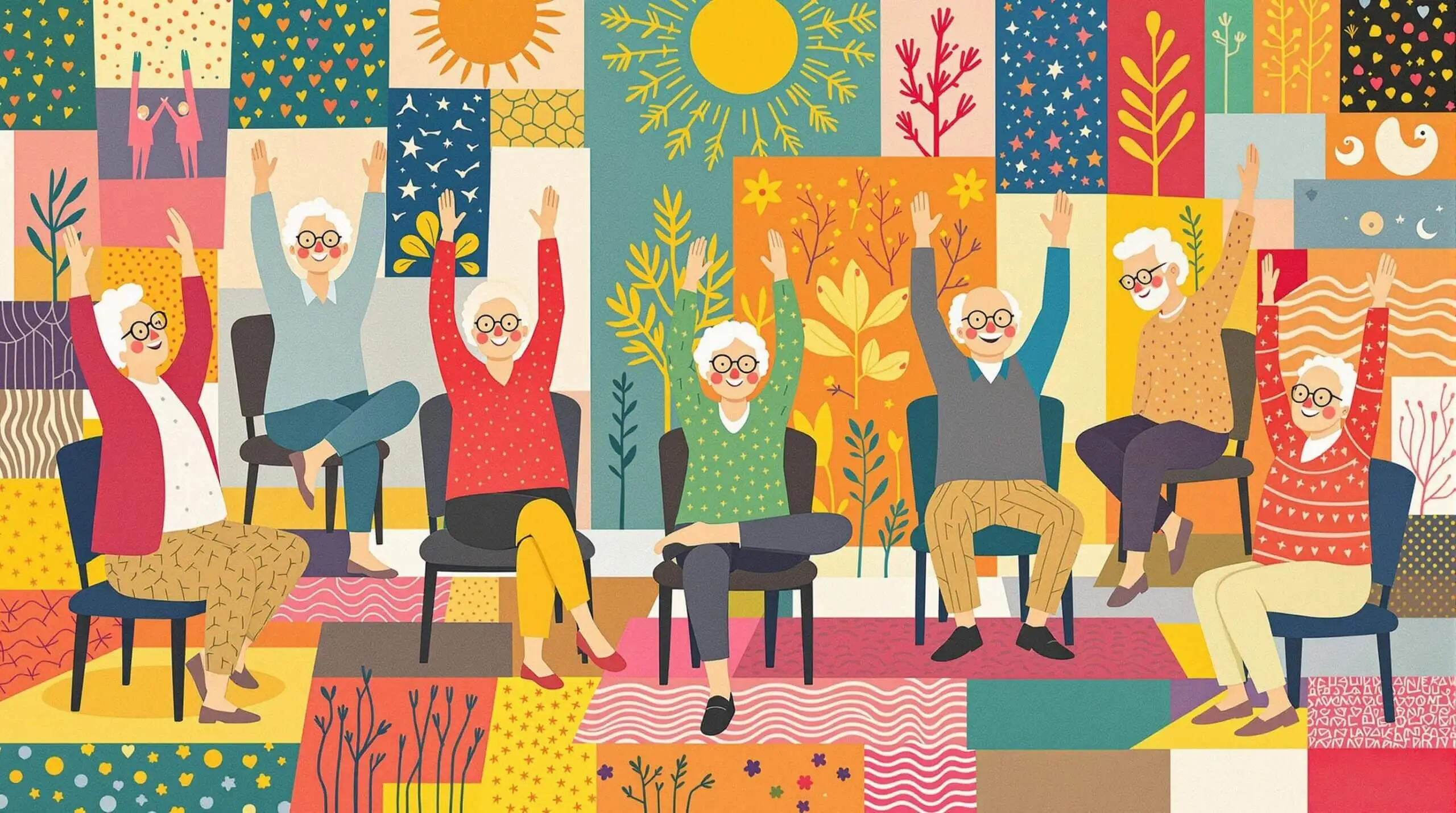Chair Yoga: Accessible Moves for Ageless Health
Discover accessible chair yoga moves designed to promote health and wellness for all ages.

Understanding Chair Yoga: A Gateway to Lifelong Wellness
What is Chair Yoga?
Chair yoga transforms traditional yoga poses into accessible movements using a chair for support. This adaptation makes yoga available to everyone, regardless of age, mobility, or fitness level. Think of it as yoga’s friendlier cousin – all the benefits, none of the complicated twists and turns on a mat.
The Origins and Evolution
Chair yoga emerged in the mid-20th century as yoga teachers recognized the need for more inclusive practices. Lakshmi Voelker-Binder, one of the pioneers, developed her chair yoga method in 1982 when a student couldn’t practice traditional yoga due to arthritis. Today, it’s practiced in senior centers, offices, and homes worldwide.
The Science Behind Chair Yoga
Research supports chair yoga’s effectiveness. A 2019 study in the Journal of the American Geriatrics Society found that chair yoga significantly reduced pain and improved mobility in older adults with osteoarthritis. Another study showed it decreased fall risk by 48% in participants who practiced twice weekly.
Benefits for Longevity
Chair yoga isn’t just about flexibility – it’s a powerful tool for healthy aging. Regular practice improves balance, strengthens core muscles, enhances breathing capacity, and reduces stress. These benefits directly impact longevity markers like cardiovascular health and immune function.

Essential Chair Yoga Moves for Better Health
Seated Breathing Exercises
Proper breathing forms the foundation of chair yoga. Simple techniques like diaphragmatic breathing strengthen respiratory muscles and increase oxygen flow. Studies show that controlled breathing exercises can lower blood pressure and reduce stress hormones – key factors in healthy aging.
Upper Body Stretches
Gentle neck rolls, shoulder shrugs, and arm stretches help maintain upper body mobility. These movements combat the effects of prolonged sitting and poor posture, which can accelerate the aging process. Regular practice helps prevent common age-related issues like frozen shoulder and neck pain.
Lower Body Strengthening
Seated leg lifts, ankle rotations, and knee extensions maintain lower body strength and circulation. These exercises are crucial for preventing deep vein thrombosis and maintaining independence in daily activities. Research indicates that strong legs correlate with better cognitive function in older adults.
Chair Yoga’s Impact on Age-Related Conditions
Managing Arthritis
Chair yoga offers gentle movement that lubricates joints without strain. Studies show that regular practice reduces arthritis pain by up to 40% and increases joint flexibility. The supported positions allow practitioners to focus on proper alignment without fear of falling.
Improving Balance and Coordination
Even seated exercises enhance proprioception – your body’s awareness of its position in space. This improvement reduces fall risk, a major concern for aging adults. Research from Florida Atlantic University found that chair yoga participants showed significant improvements in balance after just 8 weeks.
Cognitive Benefits
The mind-body connection in chair yoga supports brain health. Following sequences and coordinating breath with movement engages multiple cognitive processes. Studies indicate that regular yoga practice can slow age-related cognitive decline and improve memory function.
Key Chair Yoga Poses for Daily Practice
- Seated Cat-Cow Stretch: Supports spinal flexibility
- Seated Mountain Pose: Improves posture and breathing
- Chair Twists: Enhances spine mobility and digestion
- Seated Forward Bend: Stretches back muscles and calms the mind
- Chair Sun Salutations: Warms up the entire body
- Ankle and Wrist Rotations: Maintains joint mobility
- Seated Eagle Arms: Opens shoulder joints
- Chair Pigeon Pose: Releases hip tension
- Seated Warrior: Strengthens legs while seated
- Chair Tree Pose: Improves balance with support
Creating a Sustainable Chair Yoga Practice
Setting Up Your Space
A sturdy chair without wheels is essential. Place it on a non-slip surface with enough room to extend your arms and legs. Good lighting and comfortable room temperature help create an ideal practice environment. Keep water nearby and wear comfortable clothing that allows movement.
Establishing a Routine
Start with 10-15 minutes daily and gradually increase duration. Morning practice can reduce stiffness and set a positive tone for the day. Evening sessions help release tension and improve sleep quality. Consistency matters more than duration – regular short sessions yield better results than occasional long ones.
Safety Considerations
Listen to your body and modify poses as needed. Avoid forcing movements or holding poses that cause pain. Check with healthcare providers before starting, especially if you have specific health conditions. Use the chair back for support during standing poses until balance improves.
Advanced Aspects of Chair Yoga Practice
Breath Work (Pranayama)
Advanced breathing techniques enhance the benefits of chair yoga. Alternate nostril breathing balances the nervous system, while belly breathing increases lung capacity. These practices reduce stress and improve sleep quality – crucial factors for healthy aging.
Meditation and Mindfulness
Chair yoga creates perfect conditions for meditation. The supported seated position allows focus on mental clarity without physical strain. Research shows that combining movement with meditation increases gray matter in the brain, potentially slowing cognitive aging.
Progressive Challenges
As strength and flexibility improve, practitioners can add complexity to basic poses. Standing poses using the chair for support build confidence and stability. Adding resistance bands or light weights enhances strength-building benefits.
Practical Tips for Long-term Success
- Practice at the same time daily to build habit
- Keep a practice journal to track progress
- Join online or in-person chair yoga communities
- Set realistic goals and celebrate small victories
- Listen to your body’s signals
- Stay hydrated before and after practice
- Maintain proper posture throughout the day
- Use props like blocks or straps when needed
- Practice mindfulness during daily activities
- Share your experience with others
The Future of Chair Yoga
Chair yoga continues to evolve with technology and research. Virtual classes make it more accessible, while wearable devices help track progress and ensure proper form. Researchers are studying its potential for specific conditions like Parkinson’s disease and multiple sclerosis.
Chair yoga offers a practical path to better health and longevity. Its adaptability makes it perfect for anyone seeking to maintain or improve their physical and mental well-being. By incorporating these simple yet effective practices into daily life, practitioners can build strength, flexibility, and resilience – essential components of healthy aging. The key is starting where you are and moving forward with patience and consistency.